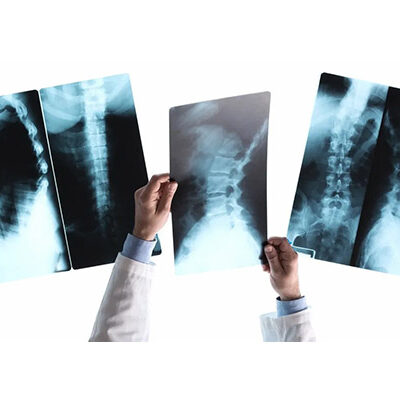Paralysis after cervical facet joint injection under sedation.
Uraine S, Strum S, Reynolds L. Loma Linda University Department of Physical Medicine and Rehabilitation. Loma Linda University Department of Pain Management. 2010. Presented at SIS (International Spine Intervention Society) conference.
Abstract:
We report about a patient who received a cervical facet injection at C5-6 and C6-7 bilaterally while under sedation with propofol. Fluoroscopic guidance was employed and no complication was thought to have occurred. Patient awoke after the procedure and had findings of right sided hemiplegia with some sensory loss and intact proprioception. Imaging showed air within the spinal cord near the level injected on the right side of cervical cord. Patient was started on decadron and physical therapies. This complication is serious and may be life threatening or debilitating. Any physician considering a cervical facet block while under sedation should consider the patient’s inability to give feedback if there is inadvertent entry into the spinal cord.
Introduction
Cervical facet joint pain is commonly treated with neural blockade without the expectation of serious side effects or complications. Possible complications include post-puncture headache, bleeding, infection, allergic reaction, CSF leak, epidural bleeding, respiratory failure, or pneumothorax. Some of these complications are due to incorrect needle placement. Direct visualization with fluoroscopy has decreased the frequency of incorrect needle placement. Other clinical indicators of incorrect needle placement which have not been fully discussed in the literature is the awake patient giving verbal feedback and if this may decrease the frequency of incorrect needle placement. In this case the patient was sedated with propofol prior to a cervicalfacet block and awoke with right side hemiplegia and a stat CT scan showed a column of air within the spinal cord.
Case Report
The patient is a 52 year old woman with chronic cervical pain who had previously undergone anterior cervicaldiscectomy and fusion without relief. Her pain management physician planned a bilateral cervical facet injection at C5-6 and C6-7 for chronic neck pain, cervical degenerative disc disease and cervical spondylosis. Procedure was done while under conscious sedation with anesthesia monitoring and local anesthesia with 1% lidocaine containing epinephrine. Patient was placed prone on the radiolucent operating table and a 3.5 inch 25 gauge spinal needle was advanced with an anterior approach until the tip of the needle was at the facet joint as confirmed by AP and oblique fluoroscopic views. A preservative-free solution of 0.5mL 1% lidocaine and 1mL of 10mg/mL kenalog was injected at each level. No complication was thought to have occurred until patient woke up and complained of right sided weakness. Physical exam demonstrated right side hemiplegia with decreased sensation and intact proprioception. CT head and neck was done which demonstrated normal brain tissue without hemorrhage and a vertical column of air within the cervical spinal cord near the injection site. Patient was started on decadron and physical therapies. Patient was then transferred to acute inpatient rehab for intensive therapies where she gradually regained motor function (strength 3/5) and sensory improvement to her right upper extremity. Patient’s decadron was tapered slowly while monitoring her clinical examination. While in rehab patient continued to have pain in her right lateral cervical area with allodynia and her home dose of opioids was increased as well as gabapentin because of the increased severity of her pain since the procedure.
Discussion
This case study brings into question if the patient had been awake for the procedure would she have experienced sensory changes which would have alerted the clinician to the improper placement of the needle tip? There is insufficient evidence for or against the use of sedation but some studies indicate that it may increase the number of false positives when compared to placebo with or without sedation. There is little published on the topic of sensations experienced during spinal cord needling for obvious reasons; however this case report highlights that it may be beneficial to be awake for such procedure.
References
Manchikanti L, Pampati V, Damron KS, McManus CD, Jackson SD, Barnhill RC, Martin JC. The effect of sedation on diagnostic validity of facet joint nerve blocks: an evaluation to assess similarities in population with involvement in cervical and lumbar regions. Pain Physician. 2006 Jan; 9(1):47-51.
Smith HS, Chopra P, Patel VB, Frey ME, Rastogi R. Systematic review of the role of sedation in diagnostic spinal interventional techniques. Pain Physician. 2009 Jan-Feb;12(1):195-206.
D.Ma, L.Gilula, K.Daniel Riew. Complication of fluoroscopically guided extraforaminal cervical nerve blocks an analysis of 1036 injections. The Spine Journal, Volume 4, Issue 5, Page S21.
Boswell M, Colson J, Spillane W. Therapeutic Facet Joint Interventions in Chronic Spinal Pain: A Systematic Review of Effectiveness and Complications. Pain Physician. 2005;8;101-114.
Boswell MV, Singh V, Staats PS, Hirsch JA. Accuracy of precision diagnostic blocks in the diagnosis of chronic spinal pain of facet or zygapophysial joint origin. Pain Physician. 2003 Oct;6(4):449-56.
Sehgal N, Dunbar E, Shah R, Colson J. Systematic Review Of Diagnostic Utility Of Facet (Zygapophysial) Joint Injections In Chronic Spinal Pain: An Update. Pain Physician 2007; 10:213-228
Ebraheim N, Liu J, Ramineni S, Liu X, Xie J, Hartman R, Goel V. Morphological changes in the cervical intervertebral foramen dimensions with unilateral facet joint dislocation. Injury. Volume 40, Issue 11, November 2009, Pages 1157-1160
Falco FJ, Erhart S, Wargo BW, Bryce DA, Atluri S, Datta S, Hayek SM. Systematic review of diagnostic utility and therapeutic effectiveness of cervical facet joint interventions. Pain Physician. 2009 Mar-Apr;12(2):323-44.
